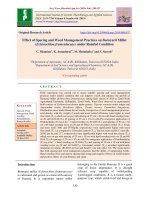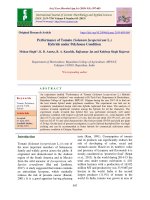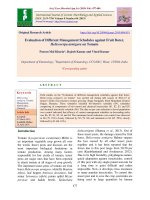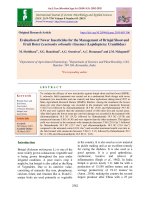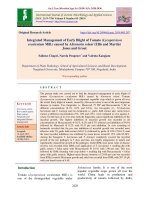Eco-friendly management of tomato fruit borer, Helicoverpa armigera under Hill condition, Uttrakhand, India
Bạn đang xem bản rút gọn của tài liệu. Xem và tải ngay bản đầy đủ của tài liệu tại đây (173.15 KB, 6 trang )
Int.J.Curr.Microbiol.App.Sci (2018) 7(10): 3008-3013
International Journal of Current Microbiology and Applied Sciences
ISSN: 2319-7706 Volume 7 Number 10 (2018)
Journal homepage:
Original Research Article
/>
Eco-Friendly Management of Tomato Fruit Borer, Helicoverpa armigera
under Hill Condition, Uttrakhand, India
Sundar Pal1*, D.K. Singh2, Ram Singh Umrao3 and Omendra Sharma3
1
DBS College of Agricultur and Allied Science, Selaqui, Dehradun, Uttrakhand-248001, India
2
Department of Oilseed section, 3Department of Entomology, C.S.A.U.A. & T.,
Kanpur-208002, India
*Corresponding author
ABSTRACT
Keywords
Helicoverpa armigera,
Tomato, efficacy,
Efficiency, Chemicals
Article Info
Accepted:
20 September 2018
Available Online:
10 October 2018
Seven insecticides tested against fruit borer, Helicoverpa armigera of
tomato, Solanum lycopersicum under field condition. The efficiency of
insecticides was similar effective after both sprays as indoxacarb 14.5SC >
novaluron 10EC > spinosad45 EC > rynaxypyr 20SC > nske 5% >
nimbicidine 5% > neemoil 1% against reduction in fruit infestation. The
maximum increased seed yield (45.00 q/ha) recorded from Indoxacarb 14.5
SC treated plots. The maximum cost benefit was return from Indoxacarb
14.5 SC treatment, Rs. 16 after per rupee investment.
Introduction
Tomato, Lycopersicon esculentum Mill is one
of the most important vegetable of the
country. India is one of the largest producers
of tomatoes in the world, second only to
China.
Around 11 % of the total world produce of
tomatoes is cultivated in India. All nutrients
especially vitamin C, B and K have good
source in tomato. India have a total area under
tomato cultivation are 773.88 thousand
hectares and total production 18731.97
thousand MT during 2015-16 (Anonymous
2017). Tomato is a major vegetable widely
produced throughout the Uttarakhand, where it
is grown both in hills as well as in plains.
Nainital, Dehradun, U.S. Nagar and Haridwar
are the four major districts producing tomatoes
and constitute about 63 percent of the total
production in the state. The major insect pests
of tomato are Helicoverpa armigera; Bemisia
tabaci; Amrasca devastans; Liriomyza trifolii;
Myzus persica and Epilachna dedecastigma
(Sharma et al., 2013).
Materials and Methods
The present investigation was carried out at
the Agriculture Farm of Doon School of
Agriculture and Allied Science, Selaqui,
Deharadun, Uttrakhand, India during rabi
season 2016-17 and 2017-18. Tomato plants
3008
Int.J.Curr.Microbiol.App.Sci (2018) 7(10): 3008-3013
transplanted from nursery to field in
Randomized Block Design in trice replication.
A total of seven insecticides viz., neemoil 5%,
nimbicidine 5%, NSKE 5%, rynaxypyr
20SC@ 100ml ha-1, spinosad45 EC @ 75
g.a.i. ha-1, novaluron 10 EC @ 100 g.a.i. ha-1
and indoxacarb 14.5 SC@ 60 g.a.i. ha-1 were
tested against Helicoverpa armigera in tomato
crop. The chemical applied two times during
study period with the help of Knapsack
Sprayer at 20 days interval. The required
quantity of chemical applied to the point of
run-off for ensuring through coverage of the
plant surface. The observations were recorded
on fruit infestation from each plot at 3rd, 7th
and 10th DAA and calculated fruit infestation
per cent. Other field practices timely
conducted.
The calculation of benefit cost ratio as
follows:
respectively, after 3rd DAS. The fruit
infestation per cent over the control were
show in increased order viz., 31.27, 44.09,
47.39, 52.41, 54.78, 66.74 and 72.21 from
indoxacarb, novaluron, spinosad, rynaxypyr,
NSKE, nimbicidine and neemoil treated plots,
respectively, after 3rd DAS. Kumar et al.,
(2017) found flubendiamide 480 SC was
superior in recording lower larval population
followed by indoxacarb 14.5 SC. The
reduction in fruit infestation per cent was
significantly superior over the control and a
range was 16.12±2.4-39.07±2.5. Spinosad and
rynaxypyr was not significantly different to
over the control.
The maximum reduction in fruit infestation
(73.29%) was recorded from indoxacarb
treated plots followed by novaluron (69.22%),
spinosad (63.67%), rynaxypyr (60.75%),
NSKE (55.52%), nimbicidine (48.95%) and
neemoil (35.25%) over the control. Ravi et al.,
(2008) recorder that indoxacarb 14.5 SC was
most effective and in reducing fruit infestation
by H. armigera tomato crop.
The efficiency of the chemicals was similar
and continues performance in reduction of
fruit infestation against fruit borer in tomato
just after 10th DAS, but indoxacarb and
novaluron were not significantly difference.
Results and Discussion
Insecticidal efficacy against fruit infestation
After 1st spray
All the treatments were founded superior to
the managing fruit infestation in tomato over
the control after first spray. The mean fruit
infestation per cent were decreased viz.,
17.23±0.9, 20.62±2.3, 28.03±0.7, 29.49±1.8,
32.61±2.4, 34.65±2.6 and 42.60±1.7 from
66.53±4.3, 67.79±2.7, 66.51±8.0, 65.95±4.0,
65.26±3.9, 65.50±5.8 and 66.24±1.2 from
indoxacarb, novaluron, spinosad, rynaxypyr,
NSKE, nimbicidine and neemoil treated plots,
Hasan et al., (2016) observed that the percent
fruit damage over the untreated control is
concerned maximum reduction in damage
(83.17%) was obtained with Indoxacarb 75 g
a.i./ha followed by Indoxacarb 60 g a.i./ha
(71.89%). Indoxacarb at 30, 40 and 50 g a.i.
/ha reduced the per cent damage by 35.94,
40.57 and 48.72 per cent respectively. Kumar
et al., who reported that 18.50 to 32.64 per
cent fruit losses could by avoided as results of
sprays of insecticides. Wajid (2016) recorded
minimum tomato fruit infestation was
observed from indoxacarb treated field (Table
1–3).
3009
Int.J.Curr.Microbiol.App.Sci (2018) 7(10): 3008-3013
Table.1 Efficiency of insecticides after first spray against tomato fruit infestation by, Helicoverpa armigera
Treatments
Indoxacarb 14.5 SC@ 60 g.a.i. ha-1
Neemoil 1%
Nimbicidine 5%
Novaluron 10 EC @ 100 g.a.i. ha-1
NSKE 5%
Rynaxypyr 20SC@ 100ml/ha
Spinosad45 EC @ 75 g.a.i. ha-1
Control
CD (at 5% level)
rd
Before
application
3 DAS
66.53±4.3
66.24±1.2
65.50±5.8
67.79±2.7
65.26±3.9
65.95±4.0
66.51±8.0
66.40±1.4
0.89
17.23±0.9
42.60±1.7
34.65±2.6
20.62±2.3
32.61±2.4
29.49±1.8
28.03±0.7
61.98±1.8
4.06
Per cent mean of fruit infestation
Reduction
7th DAS
Reduction
% over
% over
control
control
72.21
16.12±2.4
73.29
31.27
39.07±2.5
35.25
44.09
30.80±2.4
48.95
66.74
18.57±2.5
69.22
47.39
26.84±1.2
55.52
52.41
23.69±2.0
60.75
54.78
21.92±2.4
63.67
60.34±4.3
2.68
-
10th DAS
14.81±1.4
39.88±3.6
33.38±2.4
17.19±0.3
28.76±1.2
23.03±1.4
18.65±1.6
69.95±5.0
3.01
Reduction
% over
control
78.83
42.99
52.28
75.43
58.88
67.07
73.33
-
Table.2 Efficiency of insecticides after second spray against tomato fruit infestation by, Helicoverpa armigera
Treatments
Indoxacarb 14.5 SC@ 60 g.a.i. ha-1
Neemoil 1%
Nimbicidine 5%
Novaluron 10 EC @ 100 g.a.i. ha-1
NSKE 5%
Rynaxypyr 20SC@ 100ml/ha
Spinosad45 EC @ 75 g.a.i. ha-1
Control
CD (at 5% level)
rd
Before
application
3 DAS
61.83±4.1
61.83±4.1
65.56±8.6
65.56±8.6
61.83±4.1
64.21±3.3
62.22±6.1
65.16±7.4
3.58
18.93±2.8
46.35±4.7
41.24±1.6
26.45±3.0
35.02±0.8
31.30±1.4
28.83±1.7
71.31±1.8
3.61
Per cent mean of fruit infestation
Reduction
7th DAS
Reduction
% over
% over
control
control
73.45
6.64±0.8
92.08
35.01
24.94±3.0
70.24
42.16
19.15±1.5
77.15
62.91
11.50±1.7
86.28
50.90
15.38±1.7
81.64
56.10
15.27±0.9
81.78
59.57
12.52±1.6
85.07
83.81±1.7
2.01
3010
10th DAS
8.30±1.0
26.42±2.0
21.48±0.6
10.78±1.0
17.31±1.1
14.06±0.8
12.39±1.4
84.30±2.2
2.14
Reduction
% over
control
89.61
68.24
74.07
86.69
78.99
82.82
84.79
-
Int.J.Curr.Microbiol.App.Sci (2018) 7(10): 3008-3013
Table.3 Pooled economics analysis of insecticidal efficacy in tomato crop against Helicoverpa armigera during 2016-17 and 2017-18
S.
No.
Treatment
Total cost of
treatment
(Rs./ha)*
Yield
(q/ha)
Increase
yield
(q/ha)
Value of
increase yield
(Rs/ha)#
Net return
(Rs.)
CBR
1.
Indoxacarb 14.5 SC@ 60 g.a.i. ha-1
3812.50
305.50
45.00
65250.00
61437.50
1 : 16
2.
Neemoil 5%
3254.25
265.50
05.00
07250.00
03995.75
1:1
3.
Nimbicidine 5%
3478.50
270.11
09.61
13934.50
10456.00
1:3
4.
Novaluron 10 EC @ 100 g.a.i. ha-1
3525.50
299.25
38.75
56187.50
52662.00
1 : 15
5.
NSKE 5%
3594.50
272.35
11.85
17182.50
13588.00
1:4
6.
Rynaxypyr 20SC@ 100ml ha-1
2939.50
280.25
19.75
28637.50
25698.00
1:9
7.
Spinosad45 EC @ 75 g.a.i. ha-1
3550.50
290.25
29.75
43137.50
39587.00
1 : 11
8.
Control
-
260.50
-
-
-
-
*(Including =labor charge + machine charge + insecticide cost), # (Rs.14.50 kg-1).
3011
Int.J.Curr.Microbiol.App.Sci (2018) 7(10): 3008-3013
After 2nd spray
Marginal benefit cost ratio
Observation on fruit infestation in tomato
before second spray was not significant
difference in fruit infestation in each plot after
second spray and data collected at 3rd day
after spray (DAS) of insecticides that were
significantly difference. The mean per cent
fruit infestation were recorded from neemoil,
nimbicidine, NSKE, rynaxypyr, spinosad,
novaluron and indoxacarb treated plots after
1st spray at 3rd DAS viz., 46.35±4.7,
41.24±1.6, 35.02±0.8, 31.30±1.4, 28.83±1.7,
26.45±3.0 and 18.93±2.8 followed by
61.83±4.1, 65.56±8.6, 61.83±4.1, 64.21±3.3,
62.22±6.1, 65.56±8.6 and 61.83±4.1 before
spray, respectively. The fruit infestation
reduction per cent over the control in
ascending order, 35.01, 42.16, 50.90, 56.10,
59.57, 62.91 and 73.45 from neemoil,
nimbicidine, NSKE, rynaxypyr, spinosad,
novaluron and indoxacarb treated plots,
respectively. Second observation noticed at
7th DAS. The maximum mean fruit infestation
per cent reduction recorded from indoxacarb
treated plots with 92.08% (6.64±0.8) over the
control, where minimum fruit infestation was
recorded from neem oil treated plots with
70.24% (24.94±3.0) over the control.
The crop yields of tomato from all treated
plots were increase over the control. The field
yield were recorded in ascending order viz.,
5.00, 9.61, 11.85, 19.75, 29.75, 38.75 and
45.00q-1 from neemoil, nimbicidine, NSKE,
rynaxypyr,
spinosad,
novaluron
and
indoxacarb treated plots. The maximum value
of increased yield was recorded from
indoxacarb with Rs. 65250.00 ha-1 followed
by other treatments. The maximum return was
indoxacarb treatment plots viz., Rs. 16 after
each rupee investment followed by novaluron
(Rs. 15), spinosad (Rs.11), rynaxypyr (Rs.9),
NSKE (Rs.4), nimbicidine (Rs.3) and neemol
(Rs.1). Kumar et al., (2017) were recorded
that the highest grain yield (928 kg ha-1) as
well as cost benefit ratio (1:9.57) was
obtained from the treatment flubendiamide
480 SC and followed by indoxacarb 14.5 SC.
Hasan et al., (2016) recorded that the
indoxacarb treated treatments at 60 and 70 g
a.i. /ha dosage yielded the highest yield of
marketable fruits 29.16 and 29.50 tons/ ha
respectively. While in untreated control, it
was 16.66 tons/ha. Aheer et al., 1998()
reported 72.19 to 77.79 per cent yield losses.
Acknowledgement
Novaluran & spinosad and rynaxypyr &
NSKE were equally significantly over the
control. Kolarath et al., (2015) recorded that
the novaluron was best result followed by
spinosad and rynaxypyr against bod borer in
field bean where similar result was found by
Ghosh et al., (2010). Data recorded on fruit
infestation at 10th DAS in descending order
viz., 26.42±2.0, 21.48±0.6, 17.31±1.1,
14.06±0.8,
12.39±1.4,
10.78±1.0
and
8.30±1.0 from neem oil, nimbicidine, NSKE,
rynaxypyr,
spinosad,
novaluron
and
indoxacarb treated plots, respectively, where
fruit infestation reduction over the control
were 68.24, 74.07, 78.99, 82.82, 84.79, 86.69
and 89.61 per cent, respectively.
I am highly thankful to the Chairman, DBS
College of Agriculture and Allied Science,
Selaqui, Dehradun, Uttrakhand for partially
supported to carry out the research work. My
thankfulness also goes to Principal and other
staff members of the college, who provided
insight and expertise that greatly assisted the
research.
References
Aheer GM, Muhammad L, Muhammad S.
(1998). Quantitative losses of tomato
fruits caused by tomato fruit borer,
3012
Int.J.Curr.Microbiol.App.Sci (2018) 7(10): 3008-3013
Heliothis armigera (Hub.). Pak.
Entomologist.; 20(1/2):87-88.
Anonymous (2017). Horticultural Statistics at
a Glance 2017. Department of
Agriculture, Cooperation & Farmers
Welfare Ministry of Agriculture &
Farmers Welfare Government of India.
Pp-473.
Ghosh, A., Chatterjee, M. and Roy, A. (2010).
Bio-efficacy of spinosad against tomato
fruit borer (Helicoverpa armigera Hub.)
(Lepidoptera: Noctuidae) and its natural
enemies. Journal of Horticulture and
Forestry; 2(5): 108-111
Hasan W, Chhibber RC, Singh CP (2016)
Effect of Indoxacarb against Tomato
Fruit Borer (Helicoverpa armigera
Hub.) and Phytotoxicity to Tomato
Plants. Adv Plants Agric Res 3(2): 93.
Kumar J, Sharma SD, Jamwal RS. Estimation
of avoidable yield loss due to fruit
borer, Helicoverpa armigera (Hub.) in
tomato planted at different dates in
lower Kulluvally, Himachal Pradesh.
Pest Mgmt. Econ. Zool. 1999; 7(2):155159.
Kumar, S., G. Singh, S. Kumar and A. Kumar
(2017). Evaluation of some novel
insecticides
against
Helicoverpa
armigera (Hubner) in black gram
(Vigna mungo). Journal of Entomology
and Zoology Studies; 5(3): 183-185.
Ravi, M., Santharam, G. and Sathiah, N.
(2008). Ecofriendly management of
tomato fruit borer, Helicoverpa
armigera
(Hubner).
Journal
of
Biopesticides; 1(2): 134-137.
Remya Kolarath, Shekharappa, R. A. Balikai
E, B. S. Nandihalli and Y. N. Havaldar
(2015). Evaluation of newer insecticides
for the management of pod borers of
field bean, Lablab purpureus (L.)
Sweet. Karnataka J. Agric. Sci., 28(1):
107-109.
Sharma, D., Maqbool A., Ahmad H. and
Jamwal V. V. S. (2013). Meteorological
factors influencing insect pests of
tomato. Ann. Pl. Protec.Sci. 21: 68-71.
Wajid Hasan (2016). Effect of indoxacarb
against Tomato fruit borer (Helicoverpa
armigera Hub.) and phytotoxicity to
tomato plants. Advances in Plant &
Agriculture Research, 3 (2): 00093.
How to cite this article:
Sundar Pal, D.K. Singh, Ram Singh Umrao and Omendra Sharma. 2018. Eco-Friendly
Management of Tomato Fruit Borer, Helicoverpa armigera under Hill Condition, Uttrakhand,
India. Int.J.Curr.Microbiol.App.Sci. 7(10): 3008-3013.
doi: />
3013





